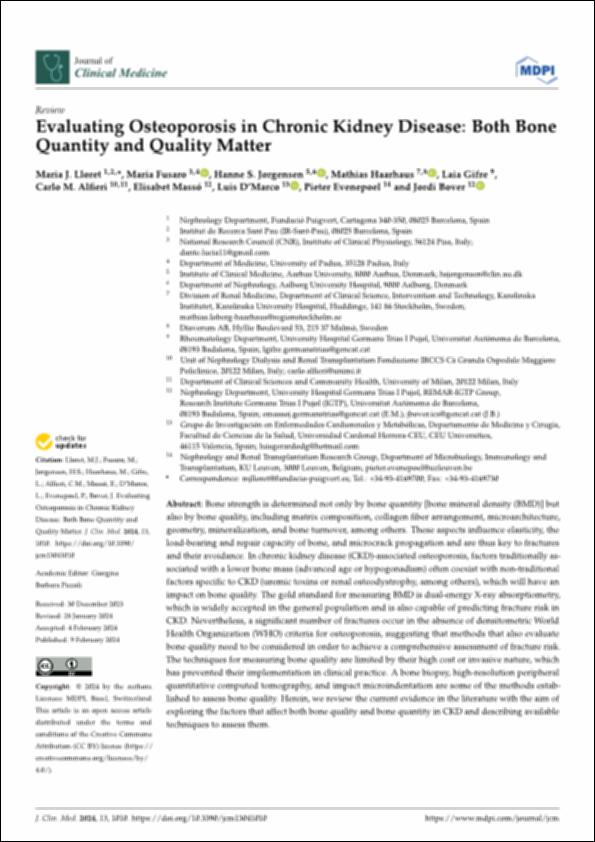Please use this identifier to cite or link to this item:
http://hdl.handle.net/10637/16176Evaluating Osteoporosis in Chronic Kidney Disease: both bone quantity and quality matter
| Title: | Evaluating Osteoporosis in Chronic Kidney Disease: both bone quantity and quality matter |
| Authors : | Lloret, María J. Fusaro, Maria Jorgensen, Hanne Haarhaus, Mathias Gifre, Laia Alfieri, Carlo M. Massó, Elisabet D'Marco Gascón, Luis Gerardo Evenepoel, Pieter Bover, Jordi |
| Keywords: | Osteoporosis; Densitometry; Densitometría; Bones; Huesos; Fractures; Fracturas; Urinary system; Aparato urinario; Diseases; Enfermedad |
| Publisher: | MDPI |
| Citation: | Lloret, M.J., Fusaro, M., Jørgensen, H.S., Haarhaus, M., Gifre, L., Alfieri, C.M., Massó, E., D'Marco, L., Evenepoel, P. & Bover, J. (2024). Evaluating Osteoporosis in Chronic Kidney Disease: both bone quantity and quality matter. Journal of Clinical Medicine, vol. 13, i. 4, art. 1010 (09 feb.). DOI: https://doi.org/10.3390/jcm13041010 |
| Abstract: | Bone strength is determined not only by bone quantity [bone mineral density (BMD)] but also by bone quality, including matrix composition, collagen fiber arrangement, microarchitecture, geometry, mineralization, and bone turnover, among others. These aspects influence elasticity, the load-bearing and repair capacity of bone, and microcrack propagation and are thus key to fractures and their avoidance. In chronic kidney disease (CKD)-associated osteoporosis, factors traditionally associated with a lower bone mass (advanced age or hypogonadism) often coexist with non-traditional factors specific to CKD (uremic toxins or renal osteodystrophy, among others), which will have an impact on bone quality. The gold standard for measuring BMD is dual-energy X-ray absorptiometry, which is widely accepted in the general population and is also capable of predicting fracture risk in CKD. Nevertheless, a significant number of fractures occur in the absence of densitometric World Health Organization (WHO) criteria for osteoporosis, suggesting that methods that also evaluate bone quality need to be considered in order to achieve a comprehensive assessment of fracture risk. The techniques for measuring bone quality are limited by their high cost or invasive nature, which has prevented their implementation in clinical practice. A bone biopsy, high-resolution peripheral quantitative computed tomography, and impact microindentation are some of the methods established to assess bone quality. Herein, we review the current evidence in the literature with the aim of exploring the factors that affect both bone quality and bone quantity in CKD and describing available techniques to assess them. |
| Description: | Este artículo pertenece a la sección "Nephrology & Urology". |
| URI: | http://hdl.handle.net/10637/16176 |
| Rights : | http://creativecommons.org/licenses/by/4.0/deed.es Open Access |
| ISSN: | 2077-0383 (Electrónico) |
| Issue Date: | 9-Feb-2024 |
| Center : | Universidad Cardenal Herrera-CEU |
| Appears in Collections: | Dpto. Medicina y Cirugía |
Items in DSpace are protected by copyright, with all rights reserved, unless otherwise indicated.


